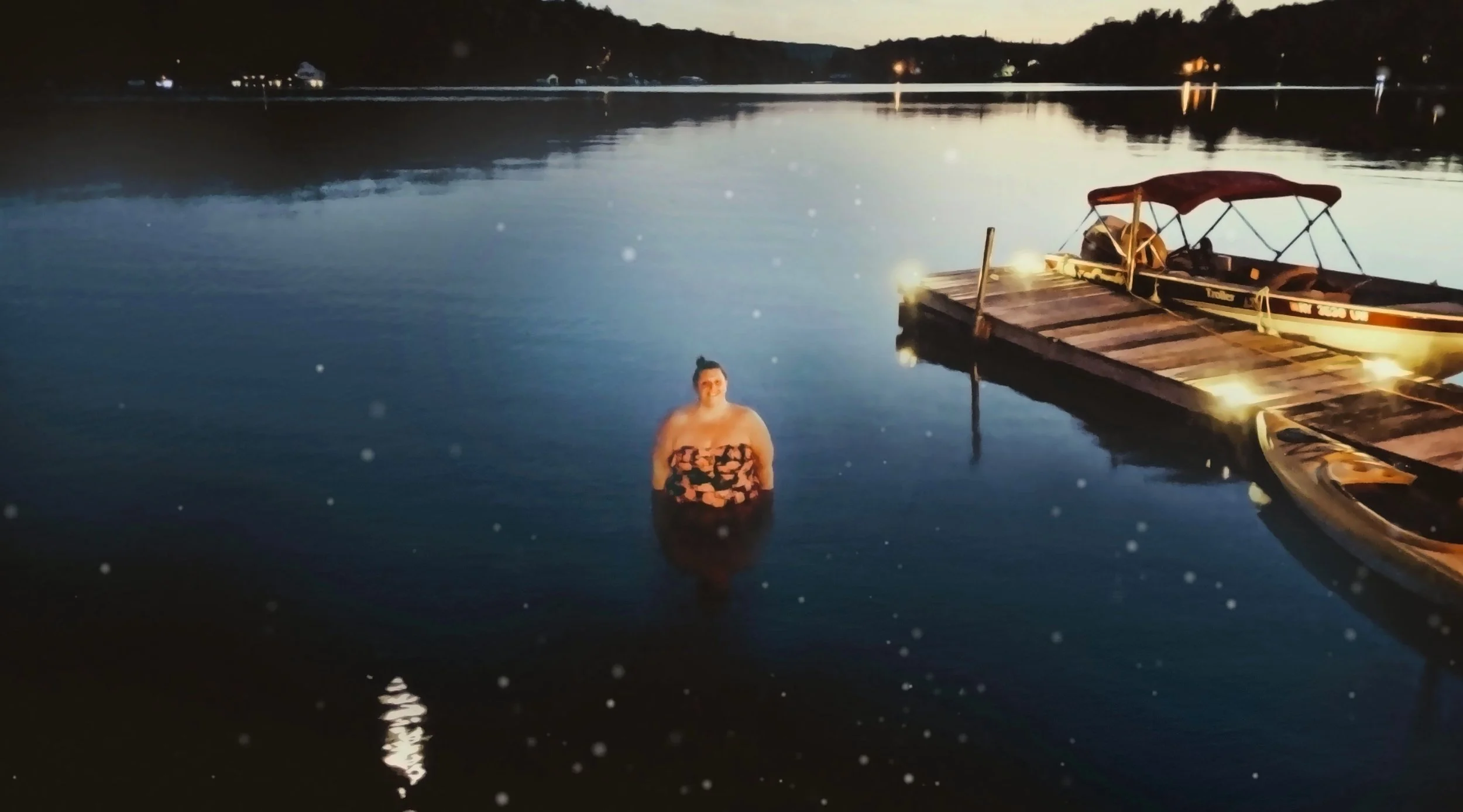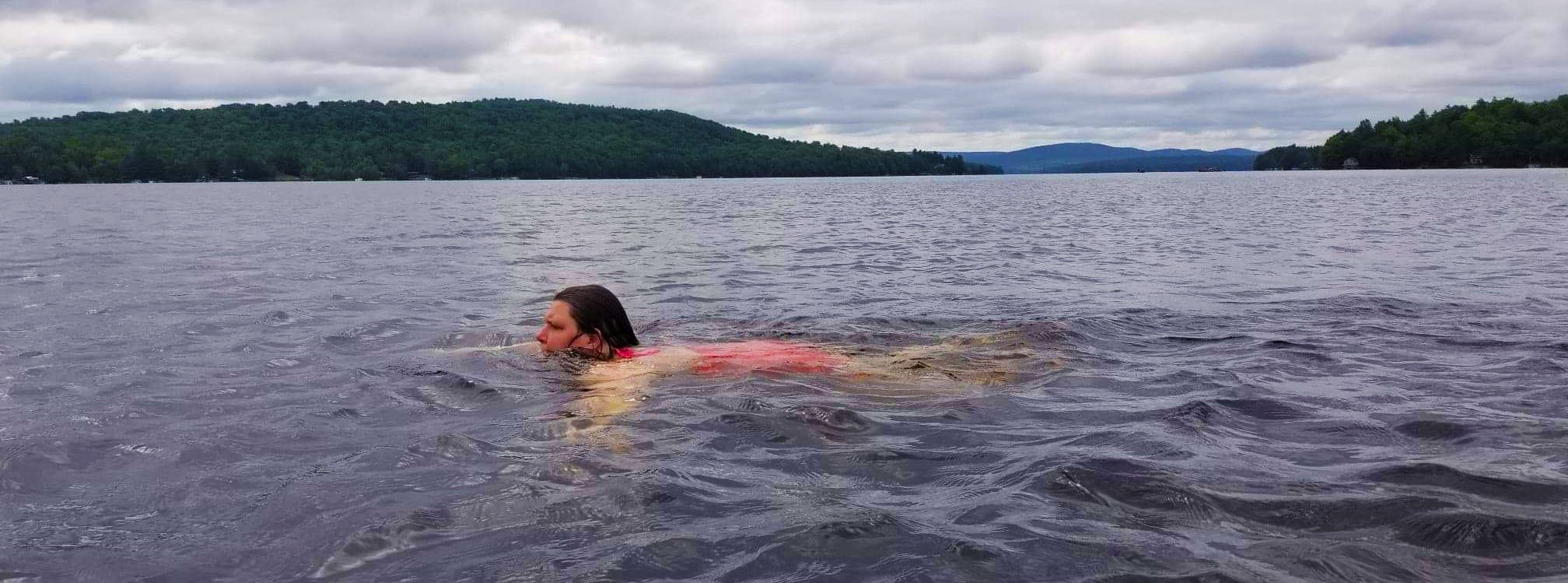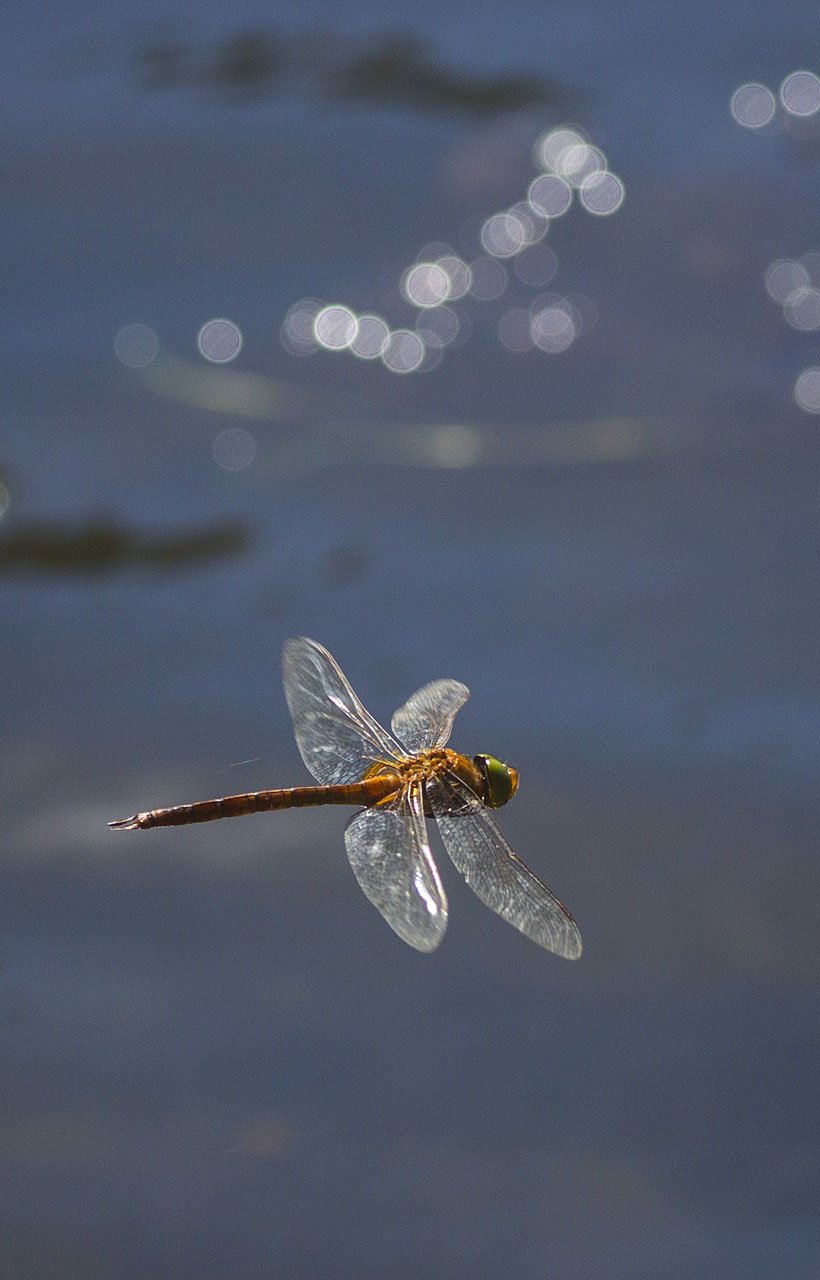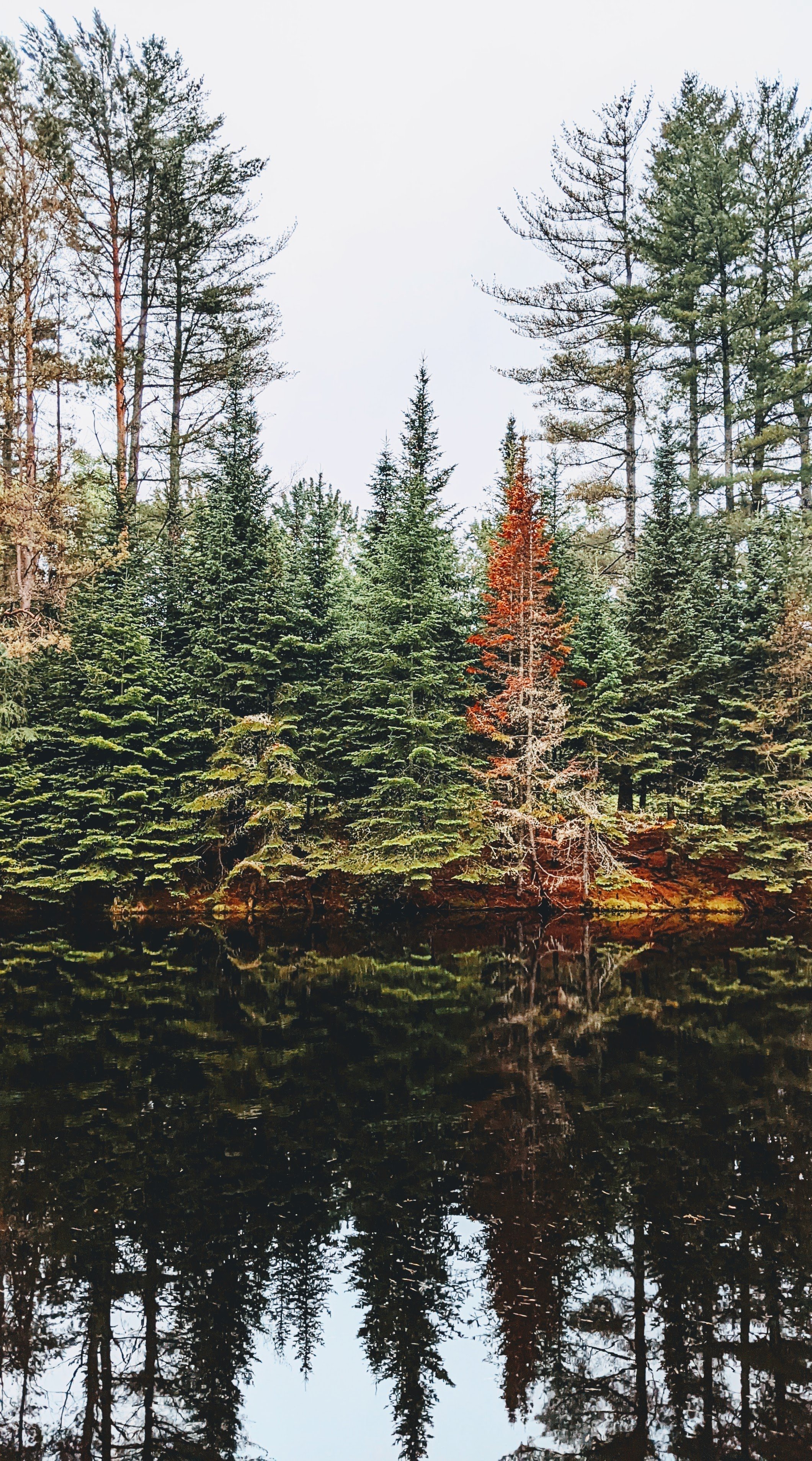Crossing Cranberry
The nature of long-distance swimming in the Adirondacks
Image credit: Megan Anne Rechin
by Megan Anne Rechin
May 19, 2022
HOUR ONE: Turtle Pacing
With one toe, I know the stairs are perilous. I crawl down, fingers tight on an old rotted rail. The expanse of Cranberry Lake and the Adirondack High Peaks stretches out in front of me. I, at once, feel small. The water is 68 degrees Fahrenheit. Good for a long swim.
Image credit: Megan Anne Rechin
My mass makes waves and pushes the dock out and in. My ripples meander toward forever as I take a second to tighten my pink halter-top straps. I sink below the surface, open my eyes for a moment, and see nothing but red filtered sunlight. Cranberry Lake is so called because of the numerous cranberry bogs that once existed here. It is an artificial lake, but I only feel wild and free once I begin my swim.
Two strokes, three strokes, I start to glide. And then, I am interrupted. A black speck is coming close, bobbing and ebbing. With it, a small wake like mine. Unafraid, I paddle closer. It is a painted turtle, and he wants to race.
I am made for turtle pacing. We both go slow. That's the kind of pace you need to swim long distances. The resistive nature of water creates a drag upon our strokes, every movement much more difficult, much more work than walking on land or riding bikes on roads. To put it in metrics, a walk can cost the average adult human 150 calories per hour. An hour-long bike ride, 350 to 450 calories. A swim? Up to 800 calories per hour. When swimming, we cannot push off and propel against the land. We can push only against the water itself. And so, the turtle and I must go slow, conserving calories to get us there and, me, back again. We thrust against the drag, overcoming the water’s hold to keep us still.
My swim will be five miles, about six hours' worth of water — much longer than typical swims; my own personal record, in fact. But the turtle doesn't mind. He has no plans except forward. The variegated yellow stripes on his neck are like a guide, and I follow him as we move the water away.
Image credit: Pixabay
HOUR TWO: Dragonfly Pit Stop
Cranberry Lake is on the edge of the Adirondacks, in New York's grandest park. Situated an hour west of the famous Lake Placid, it generally goes unnoticed — a handful of city escapers in the summer, abandoned in the winter. But, there is a secret. Nearly 75% of Cranberry Lake's shoreline is owned by New York state, which is unique for the Adirondack region, where lakefronts are oftentimes more privately owned than public. This means that areas of protected wilderness dot the shores of Cranberry Lake about as often as mosquitoes bite in the Adirondack summer — a lot.
There isn't much to do if you're not there for the trees, the mountains, or the water. Sometimes you can see a moose. Most other times, a loon. But if you're two hours into a long-distance swim, right past where the Oswegatchie River flows, you might be lucky enough to become a dragonfly pit stop.
Cross-eyed, I watch a dragonfly dart between strands of my wet hair. I tread water, worried that my breaststroke might cast droplets onto his glass wings. Like a statue, I stay still. In the distance, the hum of motorboats towing water skiers. Closer, the buzz of a dragonfly. Blue-green iridescence reflects off the still water. He is centimeters from the surface. And in a moment, my forehead becomes a dock. I am a dry place for a dragonfly, a weary traveler, in the middle of Cranberry Lake.
HOUR THREE: Dock Songs
Staying in the middle of the lake is dangerous. Boats, with their gasoline stench, zoom without care. Pontoon people are having too much fun to notice. Jet skiers ask for trouble with tricks and twirls. I am but a brown smudge in the middle of the lake, against the horizon, too small to point out. With hour two behind me, I have finally made it to the opposite shore — the home of singing docks.
I stop and float near a dock that juts out from an abandoned boathouse. Low moans from the shifting planks drop onto the water's surface, and I pretend they are singing a song of resurrection as the water returns their carbon and nitrogen to the lake bottom, becoming food for tree roots.
Low bellowing moans: an ache and a whine.
I crisscross between and below the docks on the southern shore, dragging my hands through years of built-up scum, silky and dank.
I come close to the shore to stay away from the dangers of boats. But, more than that, I come to sing with the docks.
HOUR FOUR: The Middle
Hour four brings a yawn. Swimming is not easy, and my muscles long to be fed. By now, the last meal I had before my swim is long forgotten. My stomach rumbles. My hunger hormones begin to stir, nudging neurons in my brain to say, “Hey, you’re hungry.”
When I am in the middle of the lake, a small speck dwarfed by distant mountains, gazing at the sky from an unbreakable dome-view of water and air and earth, all I can think about is eating a mountain pie.
Two terrible pieces of white bread, buttered and smooshed into a cast-iron form. Fill it with your desires: cherry pie filling, pulled pork, pizza toppings, leftover trout, a Reese's cup. Close up the pie maker and set in fire coals for two minutes on each side. Remove, and enjoy.
My stomach howls. I stop to try and focus on why I am here, to rejoice in the nature of the lake. I remember stories I've read about the Mohawk, one tribe of Native American people who call the Adirondack region home, and learning about what they ate. They hunted beaver, deer, and bear and were nourished by those animals’ fat stores. They harvested maple seeds, berries, and nuts and were nourished by those plant proteins. The Mohawk practiced artful agriculture in a land of harsh winters, stony earth, and humid summers. Swimming, I am in the same waters as their canoes.
I stop in the middle of my swim to reflect on all that has come before in this place. But I also can't wait to swim home and eat a mountain pie.
HOUR FIVE: Bark Eater
Image credit: Megan Anne Rechin
The word “Adirondack” is thought to come from “ha-de-ron-dah,” an Iroquois word meaning tree eaters or bark eaters. In speaking with living members of the Saint Regis Mohawk Tribe, I learned that many Native American people, including the Mohawk, all consumed tree bark for both nutritional and medicinal purposes.
I think of eating pine bark as I backstroke northward, heading back to camp. Spotting a nook between some granite boulders, I hoist myself out of the water. Gravity's pull weakens my legs, and I am reminded of how stiff my bones are.
I immediately meet a stalky pine. Ash brown bark peeks out from low-hanging, needle-laden branches. Snap. A piece of bark comes off, and the white phloem smiles at me. My fingers are wrinkly from the water, but I manage some strength to grab a piece of this velvet inner bark. I chew, and the taste engulfs me. Imagine, if you will, a very stale piece of gum flavored with Pine-Sol and old air fresheners, but mixed with that wild taste of fungal spores, mountain moss, and damp carpet. Taste aside, the bark will help me sustain this swim, replenishing my low levels of nutrients.
The longer I chew, the more tree-like I feel. I am rooted in this place that I love.
Snack time over. Time to swim home.
HOUR SIX: Twilight Ripples
Six hours have passed, and I am a few meters from home. The moon is out to welcome the twilight, and the sun puts on a show, scattering fluorescent pinks and purples across a cerulean sky. The pine trees are black against the fading light.
My dock is coming up, and the solar lights are just turning on. My father-in-law has a fire started in the pit. The sparks lift off to meet the stars.
I stop before they notice me and pause to lie back and look out on my swim. When you float, you can push your head, then forehead, then eyebrows, slowly beneath the surface of the water until the tops of your eyelashes can't flutter without becoming encumbered with droplets. At this point, nearly upside down, the Adirondack landscape domes around you, pulsing with wild and natural energy. With ears submerged, you can hear the last engines of boats going home. With your nose, you can smell the pine tree perfume. You are the same as the turtle and the dragonfly and the dock.
Big and small, all here for a moment, slowly swimming through life.
Now, get a towel. It's time to dry off.
Image credit: Megan Anne Rechin
Megan Anne Rechin
Megan Anne Rechin is a writer, photographer, and creative marketing consultant in Buffalo, New York. She utilizes humor, science, and creativity to engage audiences across all mediums. She received her Bachelor of Arts in science journalism from Hobart and William Smith Colleges in Geneva, New York, and will graduate in 2022 with a Master of Arts in science writing from Johns Hopkins University. Megan lives with her husband, Joe, and their two dogs, Earl and Hazel, and is supported by her amazing family and friends.






